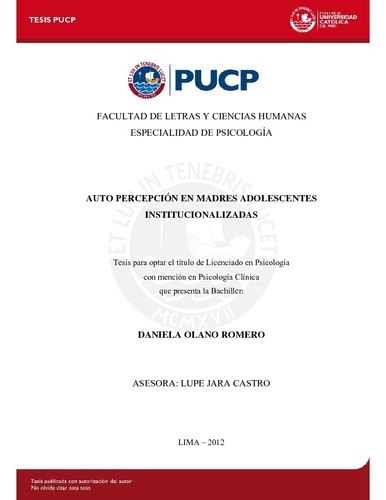| dc.contributor.advisor | Jara Castro, Lupe Isabel | es_ES |
| dc.contributor.author | Olano Romero, Daniela | es_ES |
| dc.date.accessioned | 2013-03-14T01:37:53Z | es_ES |
| dc.date.available | 2013-03-14T01:37:53Z | es_ES |
| dc.date.created | 2012 | es_ES |
| dc.date.issued | 2013-03-13 | es_ES |
| dc.identifier.uri | http://hdl.handle.net/20.500.12404/4429 | |
| dc.description.abstract | La presente investigación busca describir las características de la autopercepción en un grupo de 10 madres adolescentes institucionalizadas. La medición se realizó con el Psicodiagnóstico de Rorschach desde el Sistema Comprehensivo de Exner y una entrevista semiestructurada. Los resultados brindados por el Rorschach se contrastaron con la data de Ráez (2007), empleando estadísticos descriptivos y el Criterio de Cohen para comparar las medias, hallándose diferencias en los códigos MOR, contenido parahumano [(H)] y contenido humano parcial [Hd], así como en la suma de contenidos humanos. A la vez, se evidencia la importancia de analizar de manera integral otras variables que impactan en la autopercepción, identificando diferencias en: X%-, W:D:Dd, C´, D-, GHR-PHR, Fd y P. Se observa además que a partir del Índice de Egocentrismo parecen configurarse subgrupos con características específicas en las participantes. De otro lado, se realizó un análisis temático de las entrevistas y de las respuestas al Rorschach que dan cuenta de una autopercepción que se viene configurando a partir de concepciones deficitarias y nocivas, enfocadas en su vulnerabilidad, indefensión, desprotección, pérdida de control, y en la preocupación e insatisfacción con un cuerpo vivenciado como violentado, dañado y poco atractivo. A ello se agrega que es a partir de esta autopercepción que se vinculan con los otros, y en particular, con su bebé. Se resalta también el rol de la institucionalización en este proceso. En la discusión, se cuestiona la pertinencia y potencia de un instrumento como el Psicodiagnóstico de Rorschach para el diagnóstico y la investigación; asimismo, se propone una estrategia de análisis que suma a la ruta planteada por Exner otros niveles para revisar las variables y configuraciones que permitan una mayor y mejor comprensión de las participantes. Los resultados son reflexionados tomando en cuenta los contextos en los que han vivido las jóvenes y las experiencias vinculares provistas por los mismos, así como el momento evolutivo en el que se encuentran. Finalmente, se proponen líneas de intervención que respondan a las características de la autopercepción reportadas en este estudio.
Palabras clave: Auto percepción, Adolescencia, Maternidad, Institucionalización, Psicodiagnóstico de Rorschach. | es_ES |
| dc.description.abstract | This research tries to describe the self-perception characteristics in a group of 10 institutionalized adolescent mothers. The evaluation was performed through the Rorschach Test using Exner´s Comprehensive System and a semi-structured interview. The results from the Rorschach were contrasted with the Raez data (2007) using descriptive statistics and the Cohen Criteria to compare the means, finding differences in MOR, non human contents [(H)] and partial human content [Hd]; as well as in the sum of human contents. Moreover, this clearly shows the importance of analyzing other variables as a whole that have great impact on the self-perception identifying differences on X%-, W:D:Dd, C´, D-, GHR-PHR, Fd and P. In addition to this, we can see from the Egocentricity Index that it seems that some sub-groups with specific features in the participants are formed. On the other hand, a thematic analysis of the interviews and the responses to the Rorschach were made, showing a self-perception that is being created from the unhealthy and negative conception focused on the vulnerability, helplessness, defenselessness, loss of control and dissatisfaction with a body that is experienced as having been abused, damaged and not very attractive. Furthermore, it is from this self- perception that they relate with others and in particular with their babies. It is important to mention the role of the institutionalization in this process. In the discussion, the pertinence and strength of an instrument like the Rorschach Test for the diagnosis and research is questioned. Besides, an analysis strategy that adds the course of action of Exner to other levels is proposed to revise the variables and configurations that will allow a greater and better understanding of the participants. The results are reflected upon taking into account the context in which these youngsters have lived, and the related experiences provided by them, as well as the evolutionary moment that they are experiencing. Finally, some intervention lines that correspond to the characteristics of the self-perception reported in this study are suggested.
Key Words: Self-perception, Adolescence, Maternity, Institutionalization, Rorschach Test. | es_ES |
| dc.language.iso | spa | es_ES |
| dc.publisher | Pontificia Universidad Católica del Perú | es_ES |
| dc.rights | Atribución-NoComercial-SinDerivadas 2.5 Perú | * |
| dc.rights | info:eu-repo/semantics/openAccess | es_ES |
| dc.rights.uri | http://creativecommons.org/licenses/by-nc-nd/2.5/pe/ | * |
| dc.subject | Autopercepción en adolescentes | es_ES |
| dc.subject | Madres adolescentes | es_ES |
| dc.subject | Maternidad--Perú | es_ES |
| dc.subject | Prueba de Rorschach | es_ES |
| dc.title | Auto percepción en madres adolescentes institucionalizadas | es_ES |
| dc.type | info:eu-repo/semantics/bachelorThesis | es_ES |
| thesis.degree.name | Licenciado en Psicología Clínica | es_ES |
| thesis.degree.level | Título Profesional | es_ES |
| thesis.degree.grantor | Pontificia Universidad Católica del Perú. Facultad de Letras y Ciencias Humanas. | es_ES |
| thesis.degree.discipline | Psicología Clínica | es_ES |
| renati.discipline | 313026 | es_ES |
| renati.level | https://purl.org/pe-repo/renati/level#tituloProfesional | es_ES |
| renati.type | http://purl.org/pe-repo/renati/type#tesis | es_ES |
| dc.publisher.country | PE | es_ES |
| dc.subject.ocde | https://purl.org/pe-repo/ocde/ford#5.01.00 | es_ES |






